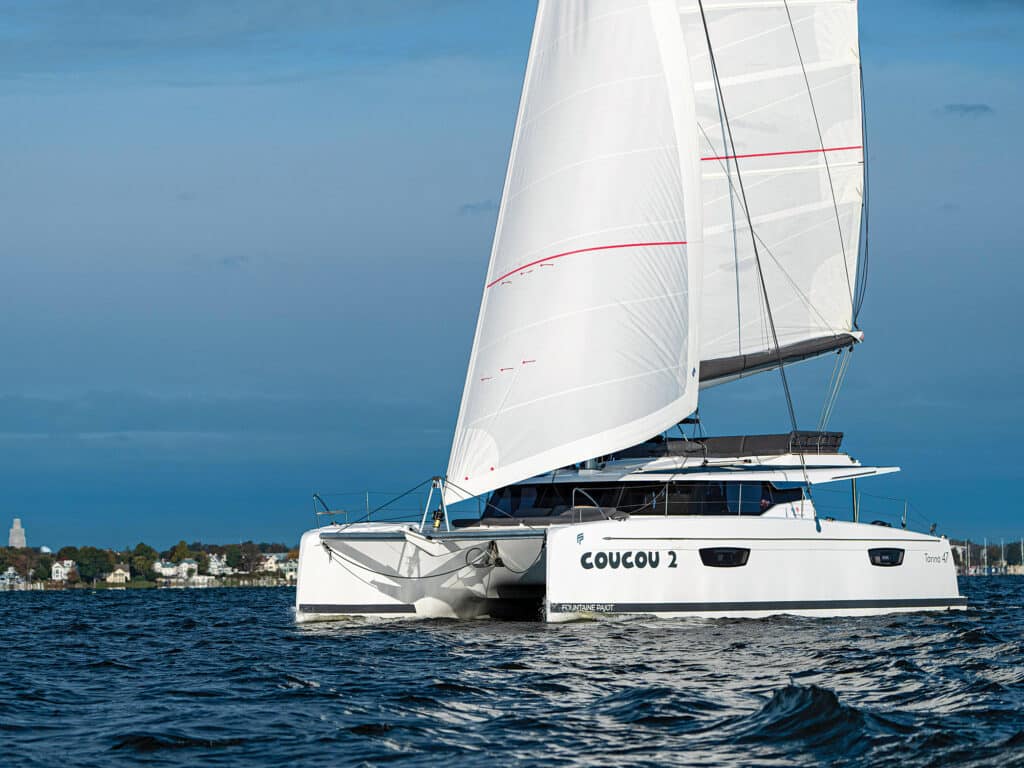
To say that French shipyard Fountaine Pajot has a long and varied history is to traffic in understatement. Founded in 1976 by a quartet that included Olympic sailor Jean-François Fountaine and offshore racer Yves Pajot, the company initially specialized in racing dinghies and IOR-rule monohulls. It later delved into large, record-setting transoceanic catamarans and trimarans. It wasn’t until 1983 that the yard pivoted to cruising cats, beginning with the Louisiana 37. In the four decades since, Fountaine Pajot has produced more than three dozen models, many named after the destinations or islands that inspired them: the Tobago 35, the Saba 50, the Eleuthera 60 and so on.
Which brings us to model year 2023, and the US introduction of Fountaine Pajot’s Tanna 47. Named for a South Pacific island in the Vanuatu chain, the 46-foot cat earned top honors as the Best Cruising Multihull in one of the stronger classes of the 2023 Boat of the Year contest. I served on the judging panel, and I have to say, the Tanna 47 is probably my favorite boat in the entire FP line. It’s structurally sound, fairly techy and good-looking, and it sails very well.
Nowadays, the naval-architecture office of Jean Berret and Olivier Racoupeau—the team responsible for designing the Tanna—seems to be everywhere, but has a long connection with Fountaine Pajot, having designed the Marquises 53 way back in 1991. The Tanna replaces another Berret-Racoupeau collaboration, the Saona 47, which had a production run of 150 boats. On the Tanna, there are plumb bows that max out the waterline, a pair of windows in each hull, a nifty wraparound coachroof window, and a raised helm to starboard topped with its own Bimini. The aesthetics are clean and crisp. A big upgrade from the Saona is the expanded lounge area on the flybridge with a sundeck and a settee (a signature Fountaine Pajot feature). There’s also an inviting sun pad on the main deck just abaft the trampolines.
Another positive aspect cited in our Boat of the Year deliberations was the versatility of the two available accommodations plans. The Quintet layout, with five double staterooms and five heads, is optimized for charter or a growing family. The other layout, called the Maestro, zeroes in on private ownership with a large owner’s stateroom that includes a vanity, desk and en suite head in the port hull. Two double-berth guest staterooms have their own heads in the starboard quarters.
The central saloon is the same in both versions, with the highlight being the commercial-grade U-shaped galley to port adjacent to the cockpit’s sliding doors. An efficient and dedicated navigation station is to port, within a few short steps to the raised wheel. The couch and lounging area in the main cabin is sumptuous and welcoming. So too is the dining and seating arrangement in the cockpit; covered by the flybridge, it’s an all-weather space for kicking back or entertaining.
The resin-infused construction employs a balsa core for a relatively light but solid structure. The standard engine package is a pair of 50 hp Volvo Penta diesels with saildrives, but our test model had the upgraded 60 hp options. At 2,700 rpm opened up, the boat made a solid 9 knots, which was the second-fastest ride in the entire Boat of the Year fleet.
Another notable feature is the array of flat, flexible Solibian solar panels that are essentially glued to the cabin top. On our test boat, they produced 1,700 watts of electricity—enough to run the primary systems (electronics, fridge, air conditioning) all day long. Fountaine Pajot is serious about addressing environmental concerns in the marine sector, and recently announced the formation of its ODSea Lab and initiative, a platform meant to accelerate technological progress with regard to materials, renewable energy, and electric propulsion. The goal is net-carbon-neutral boatbuilding by 2030, with all-electric models as an auxiliary option across the brand.
Happily, we had just about ideal conditions to conduct a test sail, with 13 to 15 knots of solid breeze coursing across Chesapeake Bay. The Tanna’s primary power source under sail is a traditional, generous, roachy full-battened mainsail, augmented by a high-cut and slightly overlapping jib. Upwind, the boat achieved a tidy 6.5 knots, which ratcheted up to a solid 7 knots once cracked off to a reach. The steering was smooth and even, and driving the big cat was a lot of fun.
Cat designers have given a lot of thought to sailhandling systems, with separation between the helm and the winches and clutches often being a high priority. I like the Tanna’s setup: a dedicated pod forward of the helm with all the controls, including a set of Lewmar electric winches, ready and at hand. The visibility, of both the seaway and the sail plan, is terrific. For shorthanded sailing, punch the autopilot and step into the pod to make adjustments. It’s simple and elegant at the same time. So, there you have it. The Tanna 47 isn’t just named for that slice of Pacific paradise; it actually has the chops to get you there.
Fountaine Pajot Tanna 47 Specifications
| LOA | 45’9″ |
| BEAM | 25’3″ |
| DRAFT | 3’11” |
| SAIL AREA | 829 sq. ft. |
| DISPLACEMENT | 29,400 lb. |
| D/L | 137 |
| SA/D | 13.9 |
| MAST HEIGHT | 70’9″ |
| WATER | 185 gal. |
| FUEL | 228 gal. |
| ENGINE | Twin 60 hp Volvo Penta diesels |
| DESIGN | Berret-Racoupeau Yacht Design |
| PRICE | $825,000 |
| WEBSITE | fountaine-pajot.com |
Herb McCormick is a yachting correspondent for The New York Times and former editor-in-chief of Cruising World. An author of five nautical books, he’s owned several sailboats, including his current Pearson 365 and Pearson Ensign.








